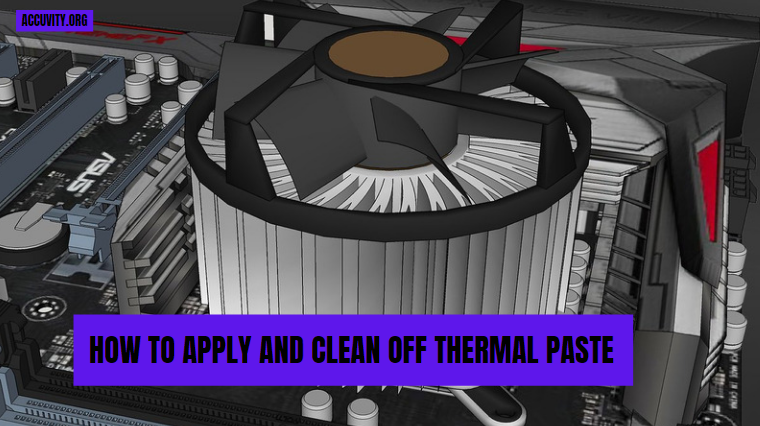
How to apply and clean off thermal paste
When you’re building your computer, the thermal paste will ensure that it doesn’t overheat. The paste serves as a sort of “middle man” between the heated CPU and the cooler, so they manage to share heat efficiently and mutually. (How to apply and clean off thermal paste)
If you’re building a new computer, this may involve applying the thermal paste on your CPU; if you’re revamping an older machine or it just happens to be experiencing problems, you’ll also have to take off any old paste before applying the new one. Just keep in mind that no matter what kind of heating issues your PC might be having (or are about to notice).
There’s nothing quite like having a “good spread” of fresh thermal paste with your CPU. Our tutorials will teach you how best to apply thermal paste to your machine, so everything runs smoothly from that point on!
What is thermal paste?
Thermal paste is used for two main reasons: Eliminating air gaps caused by fitting disjointed components together and helping transfer heat more effectively.
In a computer, thermal paste allows the heat generated by a processor to pass through the attached cooler to get spread out in the general area so that it can be dissipated into the air more quickly. Without thermal paste, CPUs can overheat and malfunction, known as burning up.
How to clean off thermal paste
To check whether your laptop’s CPU fan is working, you can open your computer and take a quick look. If the cooling fan is inside the actual CPU (instead of the outer casing) and if the CPU is in its socket on the motherboard and isn’t loose, it will be spinning. The cooling fan should not come off with gentle pressure applied to it.
What you will need:
Microfiber cloths are best to avoid scratches when cleaning the Microsoft surface. The other thing is to make sure you have rubbing alcohol with at least 90% alcohol content.
It’s also handy to use cotton swabs, but if they’re not enough, then a plastic spudger tool is excellent for getting dirt out of any little crevice in your Microsoft Surface Book or the pen.
1ST Step: Now, the first thing we want you to do is to make sure your CPU’s temperature isn’t too high. We recommend checking that your CPU’s fan isn’t blocked in any way.
2nd step: Dip a cotton swab in rubbing alcohol, then rub the tip directly on the CPU. This will help break up any hardened thermal paste so that you can more easily remove it with a plastic spudger.
3rd step: Gently use a clean section of the microfiber cloth to remove any residual thermal paste. The alcohol will evaporate almost immediately after completion.
4th step: Repeat the above process to remove any old thermal paste that may be stuck to the underside of your CPU cooler.
How to apply thermal paste
First, you need to make sure the CPU and the CPU cooler or the heatsink are clean. You’ll want to remove any dust and dirt, which may otherwise compromise your computer’s performance.
Only use a tiny portion of thermal paste — lightly squeeze out a pea-sized amount onto a lint-free cloth — be careful not to overdo it! Double-check that you have all the required equipment before beginning the application process.
What you’ll need:
Accurately read the labeling and instructions of your CPU cooler, which came with installation instructions, and familiarize yourself with the various aspects of preparing to install the CPU.
1st step: Place a pea-sized drop of thermal paste onto the middle of your CPU.
2nd step: Next, install the CPU cooler while applying downward pressure to distribute the thermal compound evenly. (Do not spread any thermal paste before installing it).
3rd step: Keep an eye on the CPU’s edges to see if any excess thermal paste or material has spilled over. Using a cleaning tool, clean off any extra thermal paste using a microfiber cloth or paper towel.
Does thermal paste need to be reapplied regularly?
One central question about the computer CPU after completing this process is whether or not it ever needs to have thermal paste reapplied. The major manufacturers of CPU chips recommend reapplying thermal paste once every few years.
If you plan on taking off your processor’s cooling device anytime soon. A typical time frame that you can expect your thermal paste to last you is anywhere from a few months to several years, but make sure you keep an eye on your computer’s performance.
Keep in mind that if the CPU starts overheating again for any reason, it might be a good indication that the thermal paste has either dried up or been wholly wiped out.






